How to Thin Paint for Wagner Sprayer
One of the biggest reasons a hobby or cheaper paint sprayer has issues is that the paint isn’t thinned correctly. So here’s how to thin paint for a Wagner sprayer. Whether you’re a beginner who’s learning how to use a paint sprayer on furniture or an experienced painter, read on for all the info you need!
No more guessing, and no more clogged paint sprayer! Thinning paint for sprayers is easier than you might think!
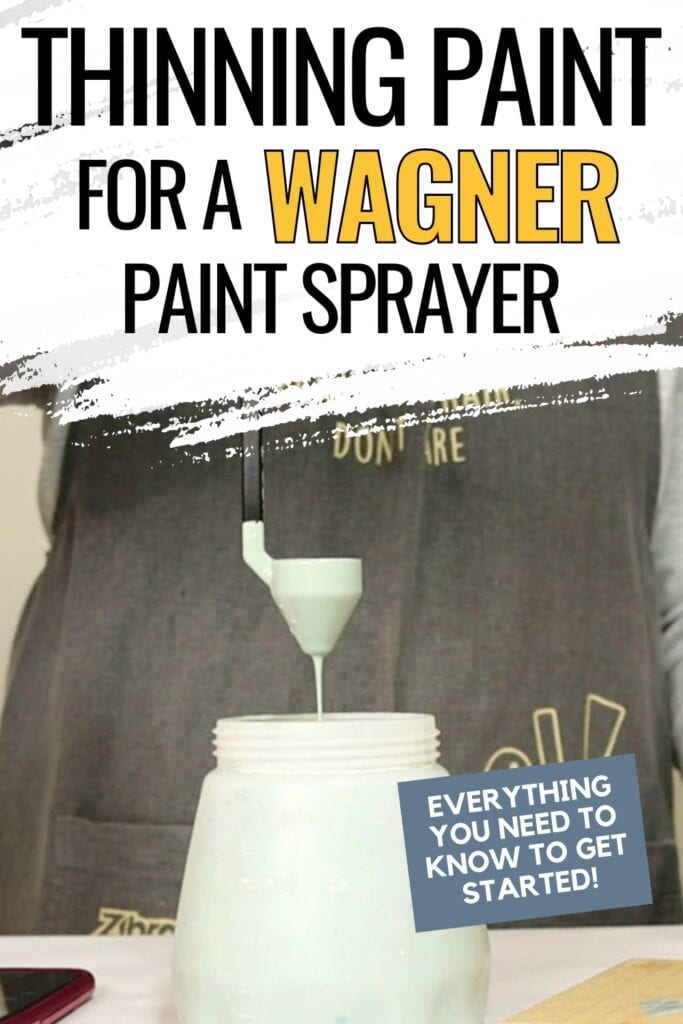
Are you tired of using a traditional paintbrush and roller to tackle your painting projects? Well, it’s time to upgrade to a Wagner paint sprayer! This powerful tool can make your painting tasks a breeze.
Before you start using your beginner friendly paint sprayer like the Wagner Double Duty paint sprayer, you need to know how to thin paint for sprayers.
In this blog post, I’ll guide you through the process step-by-step, so you can get the most out of your Wagner sprayer and achieve professional-looking results. So let’s dive in!
Best Paint Sprayers for Furniture
This step-by-step tutorial uses the Wagner Double Duty paint sprayer. Learn exactly how to use a Wagner Double Duty paint sprayer here!
Unfortunately, Wagner is phasing out the Double Duty sprayer and it seems they are replacing it with the Wagner Control Spray 250, (which looks like it is the same as the Wagner QX2 sprayer.)
These are both rated for stain, and thin paints but they don’t come with a viscosity cup like the Wagner Double Duty did. But there is a fix for that if your sprayer doesn’t come with one! Check out my honest Wagner Control Spray 250 review to learn more.
If you’re using a Wagner FLEXiO paint sprayer, check out our post on how to thin paint for Wagner FLEXiO sprayer for details that are specific to the FLEXiO sprayers.
The Wagner FLEXiO sprayers are my favorite affordable paint sprayers because they are way less finicky than these cheaper sprayers, and you get to do more things with them. Plus, you don’t have to thin the paint out as much for the FLEXiO sprayers.
How to Thin Paint for Sprayers
We’ve received so many questions about our Wagner paint sprayer that we decided we needed to dedicate a series of posts on thinning paint for sprayers.
I know it’s an overwhelming thing to learn how to use a new tool, and paint sprayers seem to be even more complicated because there are so many different kinds of paints out there.
This paint sprayer was my first sprayer, and I was so nervous that I was going to mess something up when I first tried to use it.
But now, I could never go back to brushing our paint on all of the pieces we paint. Not only does it make painting easier and faster, but it also creates that smooth, even finish you see in stores.
Today we’re talking about our Wagner paint sprayer, what we love about it, as well as how to thin chalk paint or latex paint for the sprayer.
Do You Have to Thin Paint for a Wagner Sprayer?
Yes! Actually, most beginner or hobby paint sprayers require the paint to be thinned because they don’t have enough power to suck up and push out anything thicker than stain.
But, thinning the paint a little bit is even a good idea with a professional grade paint sprayer too – it creates a prettier, less bumpy finish! The Wagner FLEXiO sprayer doesn’t require paint to be thinned! It can spray thick chalk paint!
Check out the comparison of the best HVLP paint sprayers for furniture to see how it compares to this Wagner Double Duty sprayer!
But I will say, I have used the FLEXiO sprayers many many times now, and I still thin out the thick paint to make the sprayed finish look better. It’s not rocket science and the way that I’m about to show you how to thin paint is a no guessing method!
Wagner Paint Sprayer
When we started painting furniture, we didn’t have any outdoor space to paint in, except for our apartment balcony or the shared entryway.
We lived that way for over a year while we brushed everything on. When we moved to a home with a garage and a decent sized backyard I was over the moon!
I quickly started researching paint sprayers and had so many questions about how to use them and which one to get.
After talking with my sister and mom who have paint sprayers I decided on the Wagner Double Duty paint sprayer. I’m so glad I did!
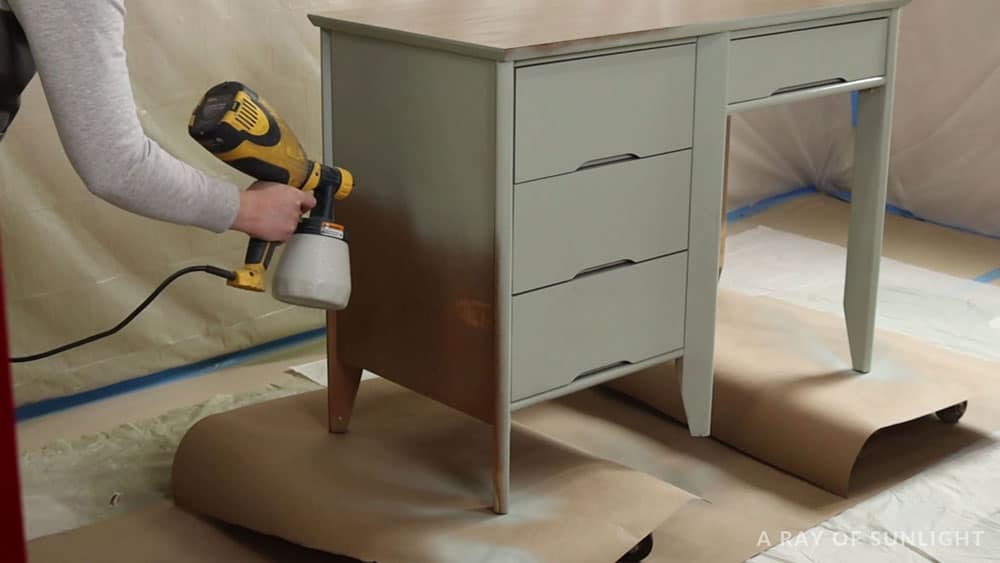
Supplies Used to Thin Paint for Wagner Sprayer
As an Amazon Associate, I earn from qualifying purchases. I also may earn from other qualifying purchases with other companies or get free product to review and use. All opinions are my own.
- Wagner Paint Sprayer
- Paint
- Flour Sifter (UPDATE: We’ve switched to using these disposable paint filters!)
- Viscosity Cup (mine came with the paint sprayer)
- Whisk
- Water (or Paint Thinner for oil-based paints!)
- Timer or Stopwatch
How to Prevent Paint Sprayers from Clogging
One of the major headaches of using paint sprayers is dealing with clogs and blockages, which can slow down your progress, be majorly frustrating, or even ruin your project.
Luckily, there is one simple step you can take to prevent clogs and keep your Wagner paint sprayer running smoothly.
One of the most important things to do is strain your paint before pouring it into the sprayer. This will help remove any lumps or chunks of dried paint that could clog up the sprayer nozzle. Use a fine mesh strainer to catch even the smallest particles.
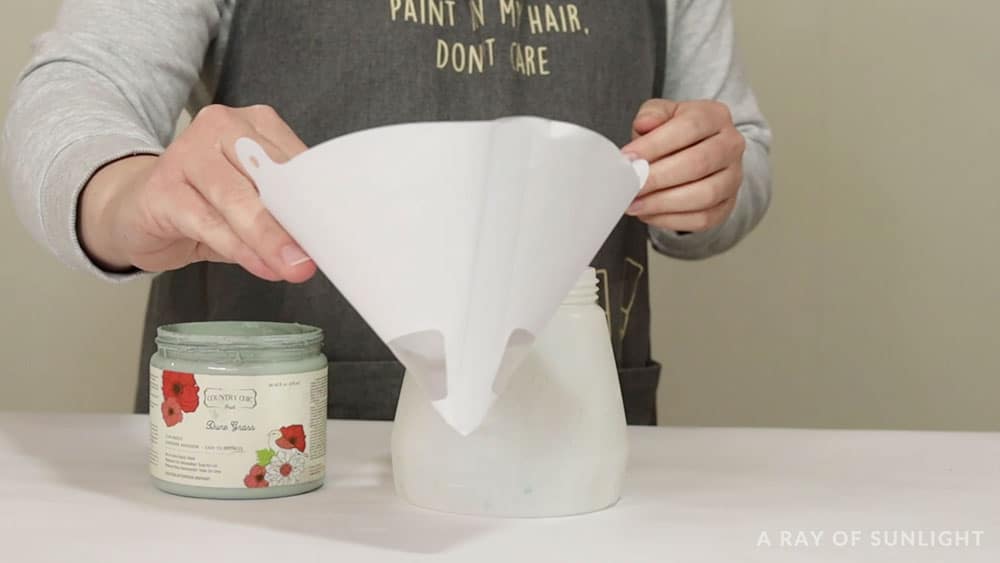

As someone who has had their share of clogged paint sprayers, I can tell you that this step is important! Trust me, taking a few extra minutes to strain your paint will save you a lot of frustration in the long run.
This isn’t the only problem you might encounter, so read through my Wagner paint sprayer troubleshooting tips and tricks to help you out.
Thinning Paint for Wagner Sprayers
Next, you’ll need to add a small amount of water (if using water-based paint!) and mix the paint and water until fully combined.
*NOTE: If you are using oil-based paint, use paint thinner to thin the paint. If you aren’t sure what type of paint you’re using, read the back of your paint container.
If it says that you need to use mineral spirits for cleanup, then you can use mineral spirits or paint thinner to thin out the paint.
If it says that cleanup is with soapy water, then you can thin out your paint with water.
Keep doing this until you think it’s the right consistency. Since every paint varies in thickness, there isn’t an exact amount of water to add to the paint.
For example, some chalk paint brands are very very thick and needs more water to get it to the consistency that this sprayer can spray out. While other paints, are thinner and don’t need as much water to get it to the right consistency.

You’ll want to only add a small amount of water at a time because if you add too much water you will have to add more paint to make it thicker again.
Usually, I’ve already tossed or cleaned my strainer and closed up the can of paint, so it’s much easier to just add water slowly and test as much as I need to until it’s the right consistency, instead of adding a bunch of water at first.
How to Use a Viscosity Cup
When you think you have it about right, grab the viscosity cup that came with the sprayer and a timer or stopwatch.
If you don’t have a viscosity cup with your sprayer (the Wagner 250 and QX2 don’t come with viscosity cups, you can purchase this viscosity cup separately.)
To test if the paint is the right consistency for the Wagner paint sprayer, dip the cup completely into the paint and start your timer or stopwatch as you bring the viscosity cup up out of the paint.

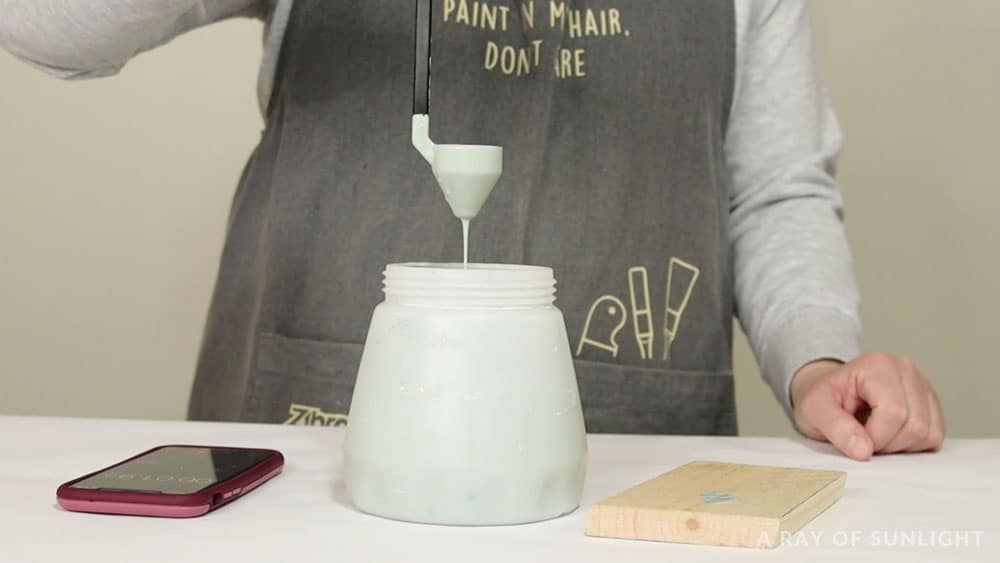
You are looking for the paint to completely run out of the bottom of the cup within 25-40 seconds. I prefer the consistency of 35 seconds, but as little as 25 or as much as 40 seconds works well too.
If the paint takes longer to run out of the viscosity cup, then I add more water (or mineral spirits if I’m working with oil based paint.)
If the paint runs out of the viscosity cup too fast, then I add more paint to the container. (Making sure that I put it through a filter first!)

Once I have the right consistency, I wash off all the tools for next time and screw the head of the paint sprayer onto the container.
That’s all there is to it! Super easy and can be done pretty quickly.
Now, here’s everything you need to know about painting furniture with a sprayer. I know it’s overwhelming at first, but it’s really not hard at all! You can do it!
I hope this answered all of those questions, and if I made more questions for you, please let me know!
Oh, and when it’s time to clean your sprayer, that’s easy too! Here’s how to clean a Wagner paint sprayer. And if you have a Wagner FLEXiO sprayer and don’t know how to clean it, you can check out our blog post on how to clean a Wagner FLEXiO sprayer here.
Paint Sprayer with No Thinning Required
If you don’t want to thin out the paint, use one of the Wagner FLEXiO paint sprayers instead of the cheaper Wagner paint sprayers that are rated for stain.
It can spray thick chalk paint without thinning it out! (I still like to add water to make the finish look perfectly smooth and not bumpy, but for most paint thinning is not required.) See it in action with this chalk painting furniture black makeover.
Wagner Double Duty Paint Sprayer Review
As someone who loves to paint furniture and other DIY projects, I can tell you that having this sprayer as my first paint sprayer was a game-changer for me.
Let me tell you a bit about why I love it so much.
I love that it comes with two containers. Since I’m always using it I end up keeping a constant supply of poly in the small container and change out the color of paint in the big container.
No air compressor needed. This baby has its own little compressor built-in, so there is no need to spend hundreds of dollars on a big enough air compressor to run your spray gun.
It’s easy to take apart and clean out. This is a must, as I’m constantly cleaning this bad boy.
My favorite part is that it is reasonably priced – especially when you take into account the other paint sprayers that have to be connected to an expensive and huge air compressor.
Not only do I love my paint sprayer, but I love how quickly it paints my furniture. You know the dreaded white paint that takes 5 coats before you get complete coverage? I would dread brushing all of those layers on before.
Now painting everything white isn’t so bad since those 5 coats each go on in seconds. Now I get to do other things while I wait for the paint to dry. Who wouldn’t want that?!
So basically if you don’t have a Wagner spray gun already, I highly recommend them! And no, I’m not getting compensated by Wagner to say that. This is completely my opinion and I purchased this spray gun on my own.
Learn more about the pros and cons of this sprayer in our honest Wagner Double Duty paint sprayer review here!
Paint for a Paint Sprayer
I personally loved chalk paint through my years of painting furniture.
We do, however have to use a top coat over the chalk paint, but honestly, who likes the feel of dried latex paint on their furniture? Not me!
Polyurethane gives the furniture a nice smooth finish – just like the finishes at the store. So it’s a win win! And, you can spray polyurethane with this paint sprayer too!
My favorite budget friendly paint is Behr paint made into homemade chalk paint. I love the color variety it provides as well as how easy it is to get. I’ve also used Country Chic Paint quite a bit, and it’s amazing.
UPDATE: Learn about my favorite and best paints to use on a dresser here!
No matter what paint you use, latex, chalk, acrylic, enamel, etc. – it has to be thinned. I know it can be intimidating, but once you’ve done it once or twice it is easy as pie.
For those who like to see visuals, I made a little video to show you how I thin my paint for my paint sprayer.
Should you thin paint for brushing or rolling?
Now what if you’re not using a paint sprayer, but instead brushing or rolling the paint onto your furniture? Do you still need to thin it out? The short answer is no, you don’t have to. But it can definitely make your painting experience easier and more enjoyable.
When using a paint sprayer, the paint needs to be thinned out so that it can properly pass through the nozzle and create an even spray pattern.
However, when brushing or rolling the paint onto furniture, there’s no need for it to go through a nozzle. This means you can use the paint as is, without having to thin it out.
If you decide to thin your paint for brushing or rolling, it can help make the application smoother and give you a more even finish.
In the end, it comes down to what feels right for you and how you like your paint consistency. It may be worth experimenting with thinning your paint to see if it makes a difference for you, especially if you’re new to painting furniture.
So we’ve shown you that thinning paint for a Wagner sprayer is a simple and easy process that can greatly improve your painting experience. Don’t stress about thinning paint, just follow our tips and you’ll be on your way to a beautiful finished project.
More Paint Sprayer Resources
- HomeRight Super Finish Max Paint Sprayer
- Fuji Q4 Platinum Paint Sprayer and the Fuji T70 Spray Gun
- Wagner vs HomeRight Paint Sprayers
- How to Use Wagner FLEXiO 5000 Paint Sprayer
- Best Paint Sprayer for Home Use
Follow us on YouTube to get more tips for painting furniture.
Or share your project with us on our Facebook Group and be part of our community. See you there!

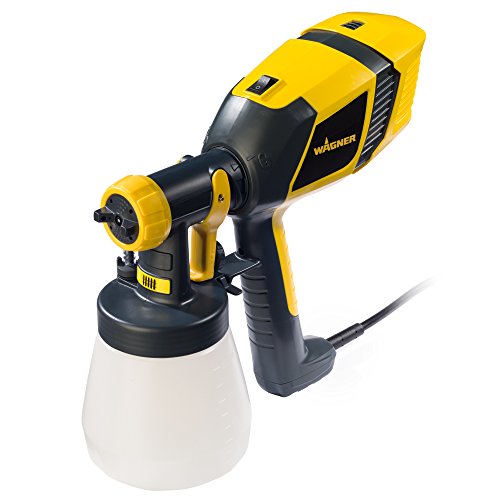


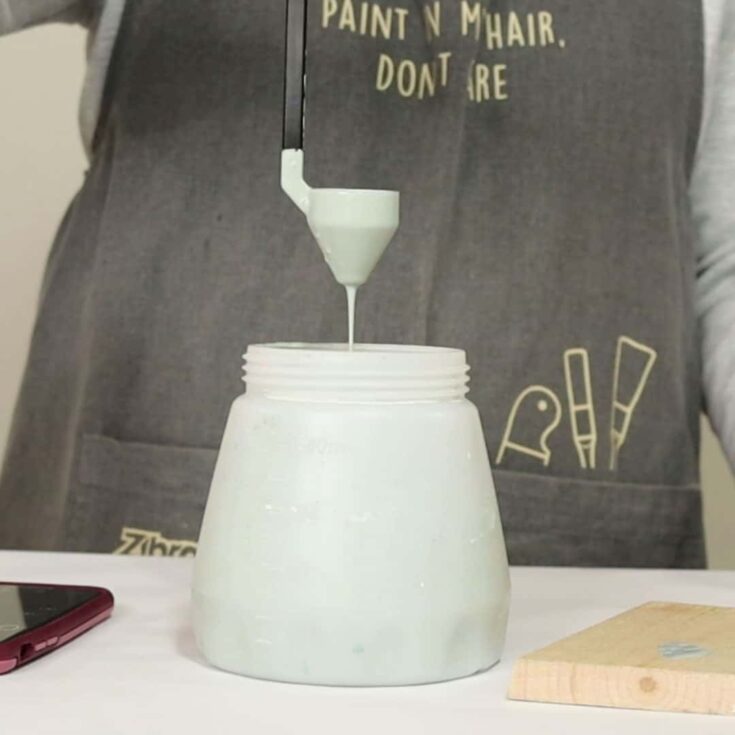



So you should have viscosity cup
There is no other way to measure ��
That's the only way I know how to get an accurate measurement.
Thank you for the video,you are using the same paint as I am. This helped me out BIGTIME,thank you….
I’m so glad! Happy painting!
Hello! I plan on buying the sprayer you have suggested. Where do I get a viscosity cup like yours?
Hey Tracey! I’m excited for you! The paint sprayer I use comes with the viscosity cup! Thats one of the many reasons I love it!
Can’t wait for you to bust out your new sprayer!
Natalie